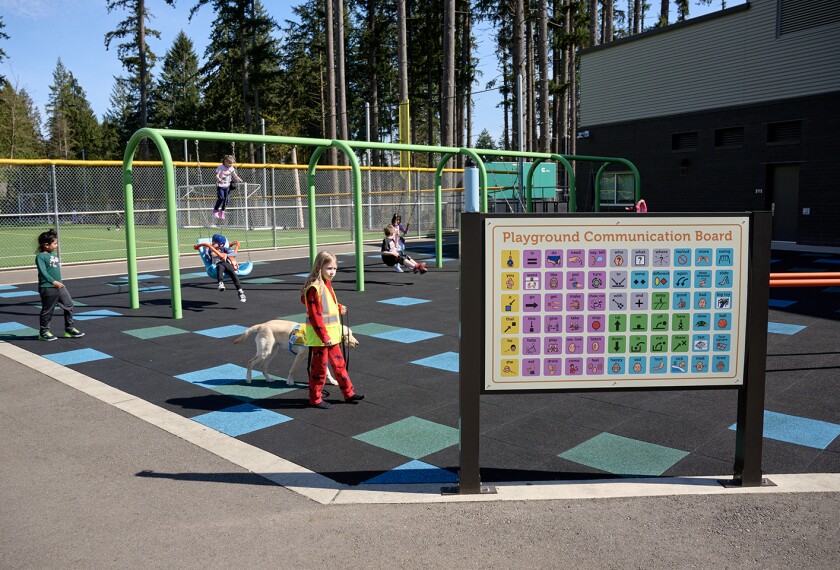For years, school officials have complained that the federal government hasn’t met what they say is its obligation to fully fund the Individuals With Disabilities Education Act, which governs the education of 6.7 million students with disabilities.
Within the next few weeks, though, the federal tap will open up, releasing an extra $6.1 billion for districts to use for special education, with another $6.1 billion to come later this year. The money is part of the massive American Recovery and Reinvestment Act, passed last month to help stimulate the recession-battered economy.
That money is on top of the $11 billion appropriated for special education in the current fiscal year.
Though grateful for the largess, school leaders face restrictions with that money. The rules governing the use of federal special education money mean that it’s unwise for districts to use the added funding to start new programs or hire new teachers. If they were to do so, districts would have to continue to pay for those costs in two years, when the federal infusion goes away, under a provision in the IDEA that requires districts to avoid making large cuts in programs from year to year.
The U.S. Department of Education, in recently released guidelines, suggests that special education aid under the stimulus measure be used for one-time expenditures. (“Ed. Dept. Outlines Conditions for Stimulus Use,” this issue.)
“Generally, funds should be used for short-term investments that have the potential for long-term benefits,” such as professional development, the department’s guidance says.
U.S. Secretary of Education Arne Duncan reiterated the point when he testified before the House Budget Committee last week.
“There’s a huge opportunity to help train regular education teachers to better work with special education children,” he told the committee.
The extra $13 billion in Title I money for schools serving large numbers of low-income students should also be used for short-term investments, particularly in early-childhood education, the Education Department guidance says.
But spending on short-term projects may leave school administrators in the position of buying equipment with one pot of money, while laying off teachers at the same time, said Bruce Hunter, the associate executive director of advocacy and policy for the American Association of School Administrators, in Arlington, Va.
Though the Education Department is trying to balance competing needs, “the statutes are prescriptive, and the regulations are prescriptive, and there’s not a lot of latitude,” Mr. Hunter said.
Like many superintendents, Mr. Hunter wasn’t critical of the Obama administration’s efforts: The economic crisis “is just bigger than anyone thought it was going to be.”
Long-Term Implications
The IDEA allows some flexibility in spending federal aid. Every federal special education dollar must be spent on special education, but the law allows districts to reduce their local contribution to special education when they receive an increase in federal funds.
That flexibility means that Judith Johnson, the superintendent of the 3,000-student Peekskill, N.Y., district, will be able to use stimulus money to preserve about five teaching positions in next year’s proposed budget. However, the stimulus measure didn’t prevent the district from sending layoff notifications last week to some 50 staff members, including teachers, clerical employees, and custodians. The employees who may end up being laid off at the end of this school year represent about 10 percent of the district’s staff.
Ms. Johnson said the stimulus money is welcome, although it’s unclear when districts in New York state will see it. She said the stimulus could prompt discussion of other important funding issues.
“I would just want to ask them, ‘Have you thought about the implications down the road? Have you thought about the fact that the rules that govern IDEA need to be changed?’” she said. “We feel very comfortable raising the questions, because we feel we’re finally being listened to.”
Michael P. Benway, the superintendent of the 6,400-student Valparaiso, Ind., district, is more fortunate than some of his colleagues. Several years ago, the district started cost-saving measures, including eliminating some positions by attrition and increasing the class loads of newly hired teachers.
The measures were not popular at the time, Mr. Benway said, but they left the district in a position where the stimulus dollars can be used to enhance programs, instead of filling a large budget gap. His special education money is tentatively slated to go toward training paraprofessionals and strengthening the district’s response-to-intervention program.
He doesn’t expect to start any new programs with the money, however. “That is very traumatic, when you introduce a program, and then you have to reduce it,” he said.
With a special education population constituting about 25 percent of the 4,600-student Salem, Mass., district, Superintendent William J. Cameron Jr. said he isn’t as concerned about starting new programs, because the district was going to be facing those costs anyway. Traditionally, Salem has paid for many special education students to attend programs outside the district.
The stimulus money can be spent increasing the district’s capacity to serve those students, he said.





